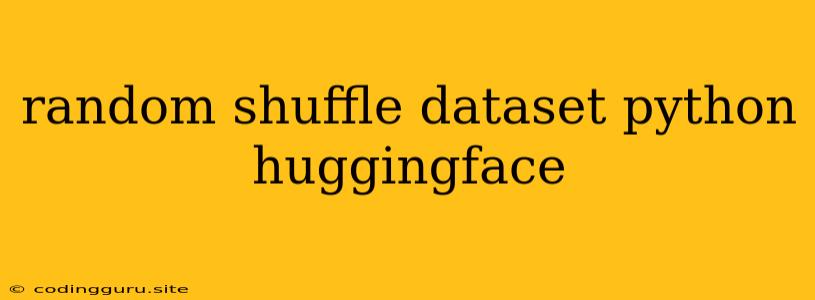Randomly Shuffling Your Datasets in Python with Hugging Face
In the realm of machine learning, particularly in the context of training models using Hugging Face libraries, ensuring your data is thoroughly shuffled before training is essential. This ensures your model doesn't develop biases due to the inherent order of your dataset. This article will guide you through the process of randomly shuffling your datasets in Python, focusing on utilizing the powerful capabilities of the Hugging Face library.
Why Shuffle Your Datasets?
Imagine training a model on a dataset where images of cats are consistently grouped together, followed by images of dogs. The model might learn to associate the presence of a cat image with the absence of a dog image, leading to inaccurate predictions. This is where shuffling your datasets comes into play.
Shuffling randomizes the order of your data points, ensuring that your model encounters diverse examples throughout training. This promotes better generalization and reduces the risk of your model learning spurious correlations between features and labels.
The Hugging Face Approach: Efficiency and Simplicity
Hugging Face, a renowned platform for natural language processing and machine learning, provides efficient and user-friendly methods for shuffling datasets. Let's dive into practical examples:
1. Shuffling Datasets for Text Classification
from datasets import load_dataset
from transformers import AutoTokenizer
# Load a text classification dataset
dataset = load_dataset('imdb')
# Tokenize the data
tokenizer = AutoTokenizer.from_pretrained('bert-base-uncased')
def tokenize_function(examples):
return tokenizer(examples['text'], padding='max_length', truncation=True)
tokenized_dataset = dataset.map(tokenize_function, batched=True)
# Shuffle the dataset
shuffled_dataset = tokenized_dataset.shuffle()
2. Shuffling Datasets for Image Classification
from datasets import load_dataset
from transformers import AutoTokenizer, AutoModelForImageClassification
# Load an image classification dataset
dataset = load_dataset('cifar10')
# Preprocess images
def preprocess_image(examples):
images = [image.convert('RGB') for image in examples['image']]
return {'pixel_values': images}
preprocessed_dataset = dataset.map(preprocess_image, batched=True)
# Shuffle the dataset
shuffled_dataset = preprocessed_dataset.shuffle()
3. Shuffling Datasets for Sequence-to-Sequence Tasks
from datasets import load_dataset
from transformers import AutoTokenizer, AutoModelForSeq2SeqLM
# Load a translation dataset
dataset = load_dataset('wmt14', language_pair=('en', 'fr'))
# Tokenize the data
tokenizer = AutoTokenizer.from_pretrained('Helsinki-NLP/opus-mt-en-fr')
def tokenize_function(examples):
inputs = tokenizer(examples['translation']['en'], padding='max_length', truncation=True)
targets = tokenizer(examples['translation']['fr'], padding='max_length', truncation=True)
return {'input_ids': inputs['input_ids'], 'attention_mask': inputs['attention_mask'], 'labels': targets['input_ids']}
tokenized_dataset = dataset.map(tokenize_function, batched=True)
# Shuffle the dataset
shuffled_dataset = tokenized_dataset.shuffle()
Tips for Effective Shuffling
- Seed for Reproducibility: Use the
seedparameter in theshufflemethod for reproducible results. - Batched Shuffling: When working with large datasets, shuffle in batches to improve efficiency.
- Dataset Splits: Shuffle your data separately for training, validation, and testing sets to prevent data leakage.
Understanding the Importance of Shuffling
Shuffling datasets is not merely a technical step but a crucial component of ensuring fair and robust model training. It helps prevent bias and enhances the generalization ability of your models.
Conclusion
By embracing the power of Hugging Face and its efficient shuffling mechanisms, you can ensure your datasets are properly randomized, leading to more accurate and reliable machine learning models. Remember that a well-shuffled dataset is the foundation for building robust and effective models.
